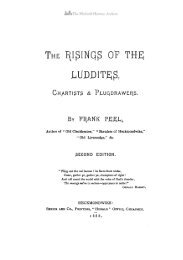OLD MIRFIELD DAYS - Mirfield - A Second Look
OLD MIRFIELD DAYS - Mirfield - A Second Look
OLD MIRFIELD DAYS - Mirfield - A Second Look
Create successful ePaper yourself
Turn your PDF publications into a flip-book with our unique Google optimized e-Paper software.
CHAPTER 11<br />
Old <strong>Mirfield</strong> and its Relationship with The Priory of<br />
Kirklees.<br />
THE Cistercian Priory of Kirklees was situated in the township or parish of Hartshead in<br />
Dewsbury. Its present claim to fame is its relationship with the outlaw Robin Hood.<br />
It is usually acknowledged to have been founded by one of the Fleming family, who were domiciled at<br />
that time at Wath-on-Dearne. They were a branch of the family sent originally to subdue the area by<br />
William the Conqueror, which they did in no uncertain manner. Yorkshire generally was laid waste, a<br />
scorched earth policy was enforced and not only this, but the whole of the populace was massacred.<br />
This founder was called Reiner Le Fleming and he granted to the Priory of Kirklees a stretch of land<br />
that covered the area from the old Walton Cross at Hartshead, across to Liversedge, to the <strong>Mirfield</strong><br />
boundary, which would be roughly as it is now, that is, to the Northern side of <strong>Mirfield</strong> Moor, bounded<br />
by the beck that crosses under the road at Roe Head near the present boundary sign and down to the<br />
river where they also built a mill, still there, and taking in the district which we knew as Blake Law or<br />
Low, now part of the new M.62.<br />
The Priory was now the owner of this fairly big stretch of land, its meadows, waters, woods, pastures<br />
and twelve additional acres of land which they held as tenants of the Fleming family, so that they may<br />
pray for their souls and for the souls of their fathers and heirs for ever.<br />
The charter granting this land is confirmed by one William, Earl of Warren who died in 1240, who<br />
states that the founder was the son of William Fleming, more or less fixing the date of the actual<br />
founding of the Priory in the reign of Henry II. It is usually accepted that Elizabeth de Stainton was the<br />
first Prioress; this is sometimes doubted, but it is recorded that she held conversations with the Abbot<br />
of Roche (who held land from Rotherham to Saddleworth) regarding their respective domains. The<br />
Kirklees Religious sphere of influence covered the same area practically as the Kirklees area of 1975,<br />
that is from the Dewsbury-Batley boundary at Morley to Stanage, still bounded there by the Friarmore<br />
area, a large part of which was held by my own ancestors as tenants of the Abbot of Roche prior to the<br />
Reformation.<br />
This same Elizabeth de Stainton is buried in a tomb behind the Three Nuns at <strong>Mirfield</strong>. An inscription<br />
round the tomb reads "Sweet Jesus of Nazareth have mercy on the soul of Elizabeth de Stainton,<br />
Prioress of this House". It is possible that she was the relative of Robin Hood usually accepted as being<br />
responsible for his death by bleeding him, after which operation he shot his famous arrow.<br />
The Priory enjoyed the income from various tracts of land, benefits of crops from areas as widely<br />
distributed as Slaithwaite, Boroughbridge, Shelf and an especial grant of 18 acres of land and<br />
messuages at Hartshead. An Inquisition was taken at York on the 22nd of January 1395 and it was<br />
decided that it was not to the injury of the King or others if the King permit a knight, John of<br />
Monteney, John Wodehouse, and William of Landale, to grant the Prioress of Kirklees 50 acres of land<br />
with the appurtenances in <strong>Mirfield</strong>, and the advowson of the church in the same place, they find a<br />
chaplain to celebrate divine service daily in the Conventual Church of Kirklees, and to receive the said<br />
land and advowson an to appropriate the said church at <strong>Mirfield</strong> to their own use for ever. A later<br />
licence in 1400 mentioned in addition to the above men, one William de Dransfield; this would be the<br />
Dransfield who originally hailed from Liley Lane.<br />
At this time the Prioress was to have all tithes in the form of sheaves of corn, hay, and the whole of the<br />
fallen wood in the area together with the use of the rectory, the vicar to enjoy any small tithes and<br />
profits accruing from his vicarate. As part of the surrender of <strong>Mirfield</strong> Church to the Prioress the<br />
Convent undertook to provide, at their own cost, a dwelling house for the vicar and to bear all the<br />
burdens likely to occur, the vicar paying 6/8d to the convent per annum for this. All their tithes in the<br />
form of corn, etc., and any other income from <strong>Mirfield</strong> Church continued to be exacted by the Prioress<br />
until the dissolution, in the case of Kirklees Priory, in 1540. The fifty acres of land granted to the<br />
Priory along with the advowson of <strong>Mirfield</strong> Church would, I should think, have been the land<br />
surrounding the present church and running down to the Northorpe area where the <strong>Mirfield</strong> of the<br />
1500's was largely located. The actual 50 acres and its situation I have never seen pinpointed, in fact,<br />
the circumstances regarding the granting of this land and church to the Priory gave rise to much<br />
controversy at the time, it had evidently only been a very infrequent procedure and its legality was<br />
35




